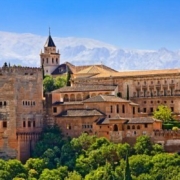The Monastery of Sant Pere de Rodes
The monastery of Sant Pere de Rodes is one of the most important of all Catalan Romanesque sites. Perched high on a hillside overlooking the Gulf of Léon, the setting is as impressive as the ruined walls and towers themselves. The first written record of the monastery dates back to 879 AD, when it was one of the many religious institutions founded in this area after the departure of the Moors. The magnificent Bendictine edifice was constructed between 979 and 1022, and was sacked and abandoned in the eighteenth century. Best preserved is the church at its centre with three wide naves and capitals of delicately carved acanthus leaves and animal heads. The 27-meter high bell-tower has fine arcades. The ruins are at their most atmospheric when shrouded in swirling mist, which is not uncommon in autumn and winter. On the hilltop above Sant Pere are the remains of a medieval castle and fantastic 360º views that sweep from Cerbère in France to Cap de Creus to the east, to Montgrí and Begur in the south, to the high Pyranees in the west. There is an interesting Romanesque church above the main parking lot. On the hillside just below the monastery there is a pretty grotto with a fountain. This is a good spot from which to look up in awe at the mighty edifice above.
The Monastery lies in the mountains, in the municipal area of El Port de la Selva in the province of Girona, Catalonia (Spain)and dominates the entire Cape Creus peninsula; it is a prime example of the Catalan-Roman era. By car the monastery can be reached via Port de la Selva or Vilajuïga. Numerous footpaths lead there as well, one of which is the path from Vall de Santa Creu. The Monastery was constructed in the hillside of the Verdera mountain below the ruins of the castle of Sant de Verdera that gave protection for the monastery. It offers exceptional views over the bay of Llançà, to the north of Cap de Creus. Near the monastery Santa Creu de Rodes is the ruins of a medieval town, of which its pre-Romanesque style church is the only remains dedicated to Saint Helena.
According to the legend, Christians coming from Rome were stranded in the bay and predicted this as a sign from God to erect a monastery here. The Christian doctrine at Sant Père de Rodes ranks among the most significant monasteries. It still dominates the bay of Llançà and Port de la Selva today. During a long period, its power reached from Barcelona far into the Roussillon. During the twentieth century the monastery was restored at considerable cost, although many consider that the work was carried out in a somewhat unfittingly modern way
The true origin of the monastery is unknown, although it is thought that it was founded by monks who disembarked in the area with the remains of Saint Peter and other Saints, to save them from the Barbarian hordes that had fallen on Rome. Pope Boniface IV then commanded them to construct a monastery. In 945AD, an independent Benedictine monastery was founded, prevailed over by an abbot. Sant Pere de Rodes reached its maximum splendor between the 11th and 12th centuries but decayed in 17th century.
In the 17th Century XVII it was attacked on several occasions and in 1793 was deserted by the Benedictine community who transferred to Vila-sacred and finally settled in Figueres in 1809 until it was finally dissolved. The monastery was declared a national monument in 1930. In 1935 the Generalitat of Catalonia initiated the first restoration work.
Being on steep hillside, the buildings are constructed in terraces. Cloisters of XII century form the central part of the complex and around them are the rest of the constructions. The Church, consecrated in 1022AD, is a prime example of the Romanesque style, well ahead of others of its time.
See this magnificent edifice on a Gourmand Breaks Luxury Private Tour, including visits to prestigious wineries and fine dining in the Emporda area.




